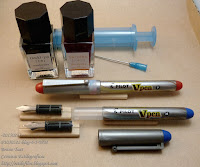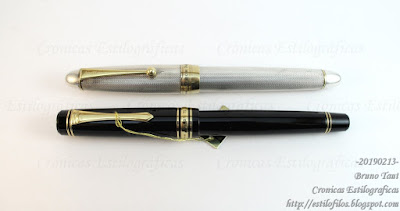Sometimes reading the pen is truly helpful. Well, mostly always.
At
the past Madrid Pen Show I saw the pen on the photograph.
 A Visconti. A Visconti?
A Visconti. A Visconti?
On it, the signs on the box and on the clip did not really match with the pen itself. The logo of Visconti and the plain inscription on the clip contrasted with the basic structure of the pen—a
Japanese eyedropper coated with red
urushi. The nib, or rather its engraving, provided the final clue—it was signed by GK,
Kabutogi Ginjiro, and the pen is, most likely, a
Ban-ei made by Sakai Eisuke (lathe work), Kabutogi Ginjiro (nib), Tsuchida Shuichi (assembly), and Takahashi Kichitaro (
urushi coating).
 A Ban-ei pen with "nashiji" decoration. Nib signed by Kabutogi Ginjiro.
A Ban-ei pen with "nashiji" decoration. Nib signed by Kabutogi Ginjiro.
The additional literature included in the box describes, in Italian, the virtues of the “lacca giapponese” (
urushi, of course) and speaks of its long history. It also includes instructions on how to fill and use the pen. Finally, it declares that the pen was part of a limited edition of 100 pens per year, but it does not disclose for how long. This particular unit was made in 1990 as it is numbered as 007/90... out of 100 pens made. (NOTE added on Sept. 2020: Some reports --see comments-- speak of serial numbers over 100 despite what the pen docs claim. So we should add some pinches of salt to those words despite coming from Visconti).
So, what was Visconti doing at that time? How come this very Japanese pen showed up under an Italian brand?
Visconti started its operation in 1988 and immediately contacted the Japanese lathe master
Kato Kiyoshi, with whom Visconti would later collaborate in the fabrication of some models, including
some versions of the Ragtime. And it is also at this time that Visconti contacted Sakai Eisuke and his team.
Apparently, there was at least two series of pens made by the Ban-ei group for the Italian brand. The first one, to which the pen shown today belongs, had a golden ring on the cap. As was mentioned before, Visconti released 100 units per year and there are records of at least two batches: 1990 and 1991. About the colors, some sources say that there were pens in
ro-iro (black)
urushi, but I am only aware of pens made in
shu-urushi (red) as the one here shown. The clip inscriptions are either "VISCONTI" or "URUSHI".
 The GK-signed nib of the Visconti Ban-ei. Note also the inscription on the clip: "VISCONTI".
The GK-signed nib of the Visconti Ban-ei. Note also the inscription on the clip: "VISCONTI".
A second series of Ban-ei pens were produced at a later date—1993 or 1995. On this occasion, the pens carried no rings and came in three colors: black (100 units), red (100 units), and green (50 units). The units I have seen have their clips engraved with the word "URUSHI", but there might be other other texts on them.
Some people speak of a third batch of pens previous to the first series here described. They could have been prototypes and test products later marketed by Visconti.
These are the dimensions of the pen I found at the
Madrid Pen Show (2017) that belongs to the first series, and was made in 1990:
Length closed: 145 mm
Length open: 126.5 mm
Length posted: 176 mm
Diameter: 16.5 mm
Weight (dry): 25.3 g
Ink deposit: 3.3 ml
 The cap ring carries the unit number of the series over the production year. This particular unit is the 007.90: number 7 (out of 100) made in 1990.
The cap ring carries the unit number of the series over the production year. This particular unit is the 007.90: number 7 (out of 100) made in 1990.
It is interesting to note that these Japanese Viscontis seem to predate those Danitrio-commissioned (
::1::,
::2::) that are much better known. However, these Visconti pens remained essentially anonymous, as was customary on Ban-ei pens, and the Italian brand did not even declare where they had been made.
Of course!—we all know by now that GK was a magnificent Italian nibmeister… But reading the pen helps to know what you had on your hands beyond what labels and inscriptions might say.
Platinum 70th anniversary, green celluloid – Sailor Yama-dori
Bruno Taut
Nakano, January 17th 2018
labels: Ban-ei, Visconti, Danitrio, Italia, Japón, nibmeister Kabutogi Ginjiro, urushi
 Urushi-nuri made in the dry plains of Spain. Nuart Cygnus (base pen by Antigua's).
Urushi-nuri made in the dry plains of Spain. Nuart Cygnus (base pen by Antigua's).

































































